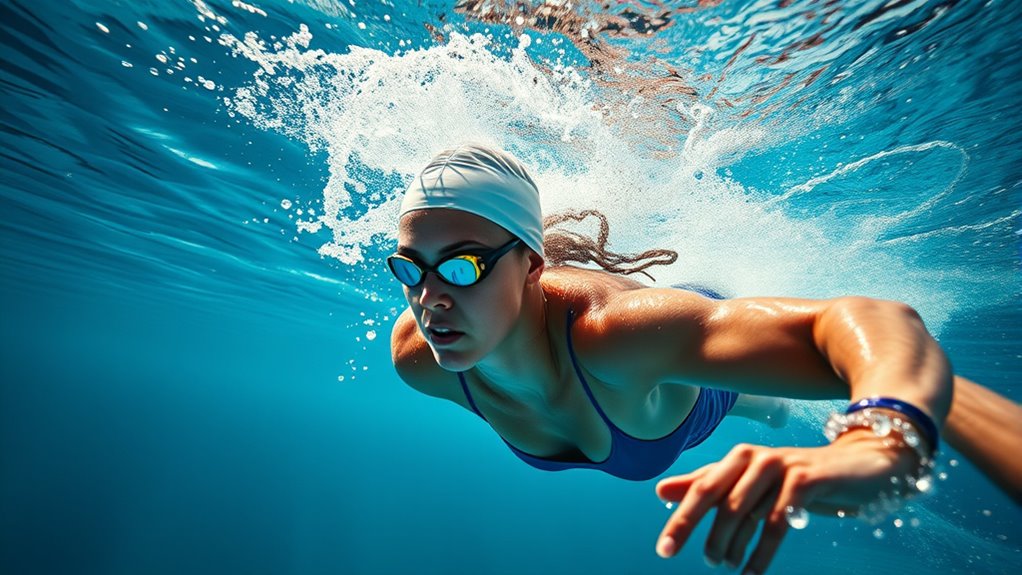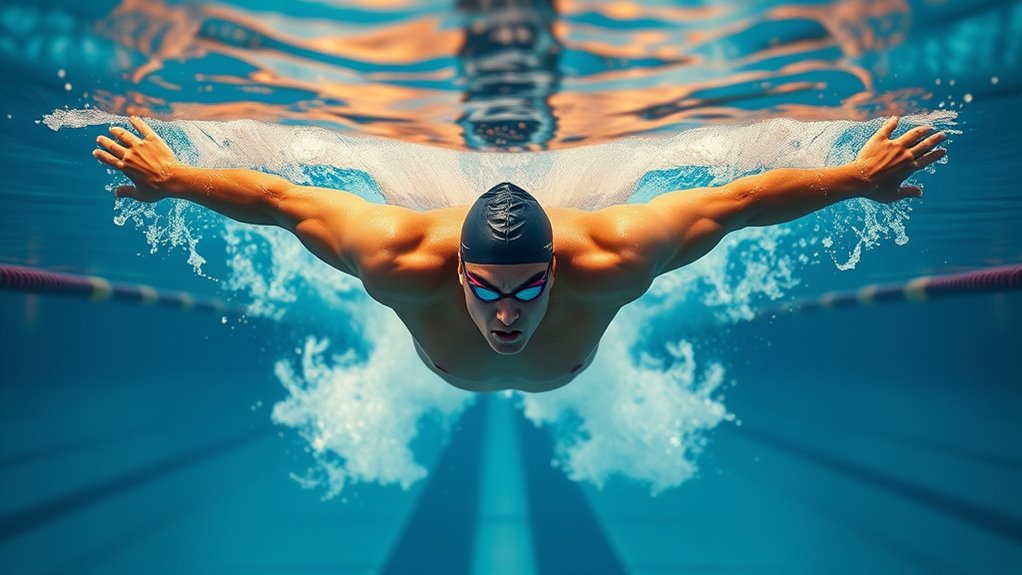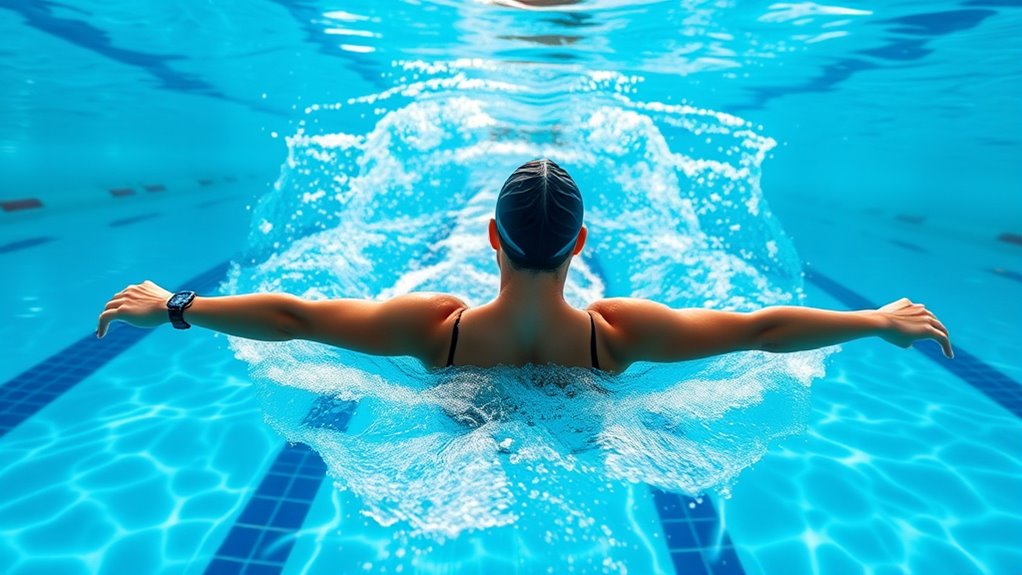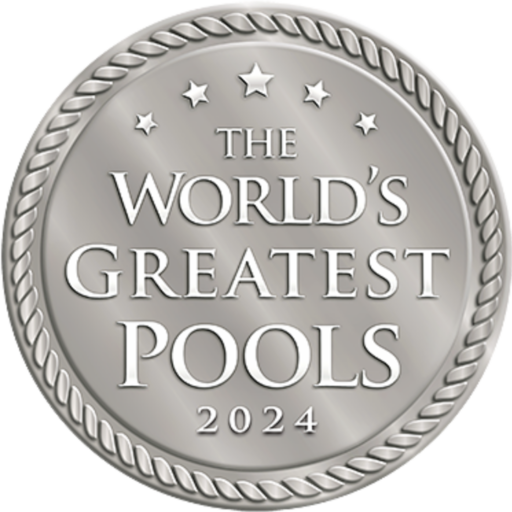Swimming workouts burn varying amounts of calories per hour: Butterfly Challenge (650-900), Aquatic HIIT (600-800), Freestyle Sprint Intervals (500-700), Mixed Stroke Circuit (500-750), Water Treading (400-600), Steady Breaststroke (350-500), and Long-Distance Backstroke (300-450). You’ll burn more calories with higher-intensity workouts that engage multiple muscle groups simultaneously. Your actual caloric expenditure depends on your weight, effort level, and technique proficiency. Uncover how to enhance your pool time for ideal calorie burn below.
Freestyle Sprint Intervals (500-700 Calories/Hour)

When properly executed, freestyle sprint intervals represent one of the most efficient calorie-burning swimming workouts available. This high-intensity training method alternates between maximum effort sprints and controlled recovery periods, optimizing both cardiovascular conditioning and energy expenditure.
For maximum caloric burn, focus on perfecting your freestyle technique—streamlining your body position, maintaining a powerful kick, and executing efficient arm pulls. A typical session includes 8-12 repeats of 50-meter sprints at 85-95% effort, followed by 20-30 seconds of active sprint recovery.
The metabolic impact extends beyond the workout itself, as the intensity triggers excess post-exercise oxygen consumption (EPOC), continuing to burn calories hours after you’ve exited the pool.
Steady-State Breaststroke Swimming (350-500 Calories/Hour)
Three key factors make steady-state breaststroke swimming a reliable calorie-burning option for swimmers of all fitness levels. The breaststroke technique creates natural intervals of propulsion and glide, optimizing calorie efficiency throughout your session. When maintained at a consistent pace for 30-60 minutes, you’ll burn 350-500 calories per hour depending on your weight and intensity.
Breaststroke’s natural rhythm creates the perfect balance of effort and recovery, making every lap count toward your calorie-burning goals.
For maximum calorie burn, focus on:
- Proper form – keep your kick narrow and powerful, avoiding excessive drag that reduces efficiency
- Breathing rhythm – establish a consistent pattern that doesn’t disrupt your momentum
- Glide optimization – extend fully after each stroke cycle, but don’t glide so long that your heart rate drops considerably
Unlike higher-intensity strokes, breaststroke allows you to maintain steady effort for longer durations, making it ideal for consistent calorie burning.
Butterfly Challenge Workout (650-900 Calories/Hour)

While breaststroke offers sustainable calorie burning, the butterfly stroke raises your swimming workout to a considerably higher metabolic demand. This challenging stroke engages your entire body simultaneously, requiring powerful coordination between your core, shoulders, and legs.
A standard butterfly challenge workout might include 5-8 sets of 50-meter butterfly sprints with 45-second rest intervals, burning 650-900 calories per hour depending on your intensity and body composition. For maximum efficiency, focus on proper butterfly technique—keeping your undulation fluid and your recovery relaxed to prevent premature fatigue.
Workout variations can help you build butterfly endurance gradually: try butterfly arms with freestyle kick, then progress to full butterfly in 25-meter segments. Even advanced swimmers should incorporate adequate recovery periods to maintain proper form throughout this high-intensity stroke.
Water Treading and Resistance Training (400-600 Calories/Hour)
The often overlooked practices of water treading and resistance training offer substantial caloric expenditure without requiring traditional swimming strokes. Water resistance naturally intensifies every movement, creating a challenging workout that engages multiple muscle groups simultaneously. You’ll burn 400-600 calories per hour while improving core stability and cardiovascular endurance.
For maximum effectiveness, incorporate these high-intensity elements:
- Vertical kicking with dumbbells overhead – engages shoulders, core, and legs while maximizing muscle engagement
- Resistance band exercises performed while treading – adds targeted resistance to specific muscle groups
- Interval treading (30 seconds fast/30 seconds recovery) – spikes heart rate and increases metabolic demand
These techniques optimize caloric expenditure through consistent muscle engagement against water resistance, offering effective alternatives to traditional lap swimming while delivering comparable energy expenditure.
Long-Distance Backstroke Endurance Session (300-450 Calories/Hour)

Maintaining proper backstroke form with extended arms and a steady flutter kick will enhance your calorie expenditure during long-distance sessions. You’ll burn more calories by alternating between steady pace swimming and short backstroke sprint intervals, rather than maintaining consistent speed throughout. Monitoring your heart rate during backstroke training sessions enables you to improve workout intensity, ensuring you remain in the 60-80% maximum range for ideal fat burning and endurance development.
Proper Form Boosts Calorie-Burn
Because proper backstroke technique enhances efficiency, you’ll achieve greater calorie expenditure during long-distance sessions ranging from 300-450 calories per hour. Research demonstrates that refined swimming techniques markedly impact metabolic demand and calorie efficiency during sustained backstroke workouts.
To optimize your calorie burn while maintaining proper form:
- Position your head neutrally with ears submerged, eyes directed at the ceiling, creating a streamlined body position that reduces drag by 15-20%
- Maintain consistent 180° shoulder rotation with each stroke cycle, increasing muscle recruitment across major muscle groups
- Execute a deliberate 6-beat kick pattern that stabilizes your core while contributing approximately 30% of your propulsive force
These evidence-based adjustments guarantee you’ll enhance energy expenditure throughout extended backstroke sessions while reducing injury risk and improving general performance metrics.
Steady Pace Versus Intervals
While steady-pace backstroke sessions maintain consistent energy expenditure at 300-350 calories per hour, interval training can enhance your caloric burn to 400-450 calories hourly through intensified metabolic demands.
When you swim backstroke at a steady pace, you’ll engage your posterior muscle chain continuously, creating a sustainable caloric deficit. This approach works well for endurance building and recovery days.
Incorporating intervals—alternating between 2 minutes of vigorous backstroke and 30 seconds of active recovery—triggers excess post-exercise oxygen consumption (EPOC), elevating your metabolism for hours afterward. Research published in the Journal of Sports Sciences demonstrates that swimmers who incorporate intervals twice weekly improve their caloric expenditure by 18% compared to those maintaining steady pace exclusively.
For ideal results, combine both approaches in your weekly training regimen.
Heart Rate Monitoring Benefits
Heart rate monitoring during long-distance backstroke sessions offers critical insights that can enhance both your calorie expenditure and training effectiveness. Research indicates that maintaining your heart rate within 60-70% of your maximum during backstroke endurance work optimizes fat utilization while sustaining adequate intensity for cardiovascular adaptations.
For ideal monitoring accuracy during your backstroke sessions:
- Position your waterproof heart rate monitor snugly beneath your swim cap for continuous data collection
- Establish your personalized heart rate zones based on a recent threshold test rather than lifespan-based formulas
- Track your heart rate recovery between sets to quantify improving cardiovascular efficiency
Mixed Stroke Circuit Training (500-750 Calories/Hour)
Circuit training that incorporates multiple swim strokes delivers one of the most efficient calorie-burning workouts in the pool. By alternating between freestyle, backstroke, breaststroke, and butterfly, you’ll engage different muscle groups while preventing adaptation and plateaus.
A typical mixed stroke circuit involves 50-100 meter sets of each stroke with minimal rest periods between changes. This approach enhances calorie efficiency by elevating your heart rate throughout the entire session. Research shows that swimmers who incorporate mixed stroke benefits into their routines burn 20-30% more calories than those who stick to a single stroke.
For best results, structure your circuit with your strongest stroke initially and most challenging last, maintaining intensity throughout the 30-45 minute workout to achieve the full 500-750 calorie burn.
Aquatic HIIT Workout (600-800 Calories/Hour)
Aquatic HIIT workouts dramatically increase your calorie burn by alternating between high-intensity swimming sprints and short recovery periods. You’ll optimize results by structuring your workout with 30-second all-out efforts followed by 30-90 seconds of active recovery, repeating this pattern for 20-30 minutes. Research shows these structured intervals can enhance your metabolic rate for hours after your swim session ends, making HIIT one of the most efficient approaches for calorie expenditure in the pool.
Intensity Boosts Results
When you’re looking to optimize caloric expenditure in the pool, high-intensity interval training (HIIT) delivers exceptional results. Research demonstrates that alternating between maximum effort and active recovery periods greatly increases your metabolic rate for up to 48 hours post-workout. This phenomenon, known as excess post-exercise oxygen consumption (EPOC), amplifies workout effectiveness beyond the time spent in the water.
To enhance intensity variations in your aquatic HIIT session:
- Incorporate 30-second all-out freestyle sprints followed by 30 seconds of moderate backstroke recovery
- Add resistance tools like hand paddles or drag suits during high-intensity intervals
- Perform explosive underwater dolphin kicks off each wall to engage your core and raise heart rate
Interval Structure Examples
Structuring your aquatic intervals effectively transforms theoretical HIIT principles into practical, calorie-torching workouts. Consider these evidence-based interval variations to maximize your 600-800 calorie hourly burn:
- 30/30 Split: Alternate 30 seconds of maximal-effort freestyle with 30 seconds of active recovery using breaststroke
- Pyramid Protocol: Swim hard for 15, 30, 45, 60, 45, 30, 15 seconds with equal rest periods
- Tabata Method: Eight rounds of 20 seconds all-out butterfly or sprint crawl with 10 seconds rest
- Distance Variation: Sprint one length, moderate pace return, repeat 10 times
These structured intervals improve workout benefits including enhanced EPOC (excess post-exercise oxygen consumption), better stroke efficiency, and increased metabolic rate. For best results, complete 2-3 HIIT swimming sessions weekly, allowing 48 hours between high-intensity workouts.
Frequently Asked Questions
How Does Water Temperature Affect Calorie Burn While Swimming?
Water temperature considerably impacts your calorie burn while swimming. In colder water (below 70°F), your body works harder to maintain core temperature, increasing caloric expenditure by up to 25-30%. This effect combines with water resistance to boost metabolism. However, extreme cold may reduce swim intensity and duration, potentially decreasing total calories burned. Conversely, warmer water (80°F+) requires less energy for thermoregulation but allows you to maintain higher swim intensity for longer periods.
Does Swimming Build Muscle as Effectively as Weight Training?
Swimming doesn’t build muscle as effectively as traditional weight training. While you’ll experience some muscle growth from swimming due to water resistance, strength training offers progressive overload that’s essential for significant hypertrophy. Swimming primarily develops muscular endurance rather than maximal strength or size. For best results, you’ll benefit from combining both activities—swimming for cardiovascular fitness and lean muscle tone, and weight training for targeted strength development and substantial muscle growth.
How Soon After Eating Should I Wait Before Swimming?
You should wait 30-60 minutes after eating small pre-swim snacks and 2-3 hours after consuming a full meal before swimming. Digestive timing matters because blood is diverted to your stomach during digestion, potentially causing cramps if you swim too soon. Light, carbohydrate-rich snacks are ideal for pre-swim nutrition if you’re pressed for time. For larger meals containing protein and fat, longer waiting periods are necessary to guarantee comfortable and safe swimming conditions.
Can Swimming Help Reduce Cellulite or Target Specific Body Areas?
Swimming can’t specifically target cellulite reduction in particular body areas. The notion of “spot reduction” isn’t supported by scientific evidence. However, swimming is an excellent full-body workout that burns calories and builds muscle, which may improve your general body composition and potentially reduce the appearance of cellulite over time. For best results, incorporate varied targeted workouts including different swimming strokes that engage multiple muscle groups simultaneously rather than focusing on specific areas.
How Does Swimming Compare to Running for Joint Health?
Swimming offers significant joint health benefits compared to running. When you’re in water, buoyancy reduces your body weight by approximately 90%, minimizing impact on your joints. Running typically creates forces of 2-3 times your body weight with each step, potentially stressing knees, hips, and ankles. Swimming provides effective cardiovascular exercise without the repetitive joint impact that runners experience. For those with arthritis, joint injuries, or obesity, swimming’s low-impact nature makes it an ideal exercise alternative while still building strength and endurance.



